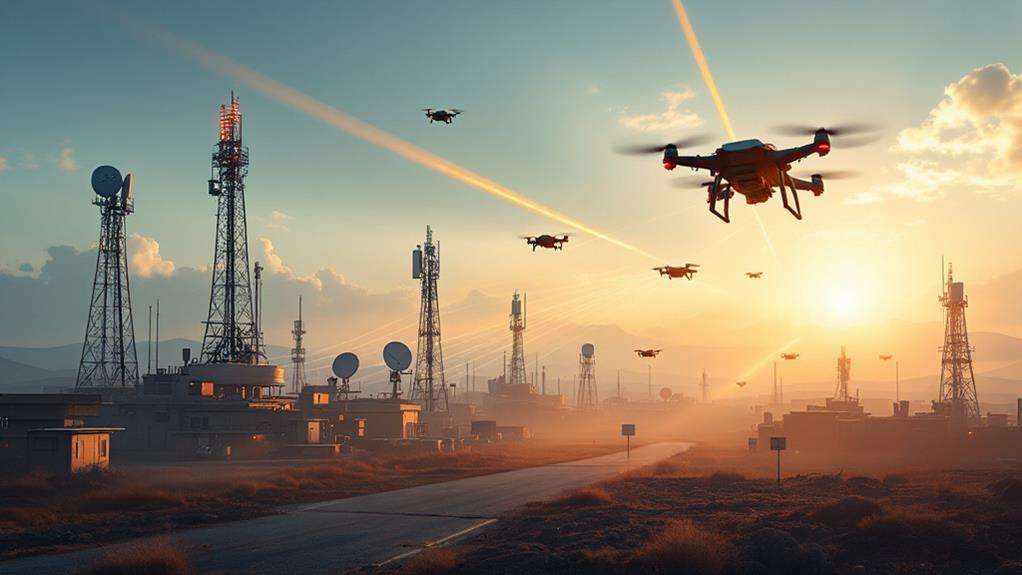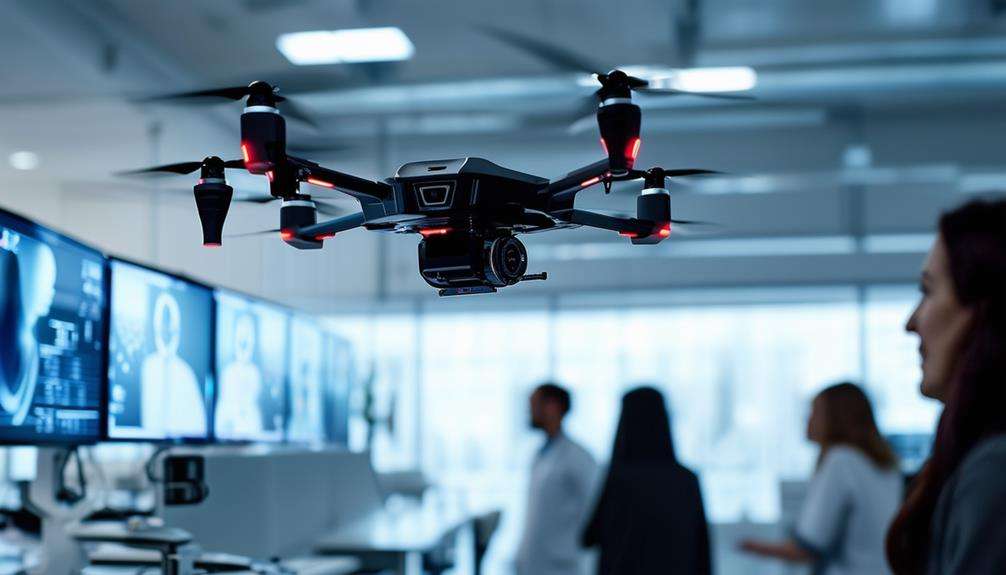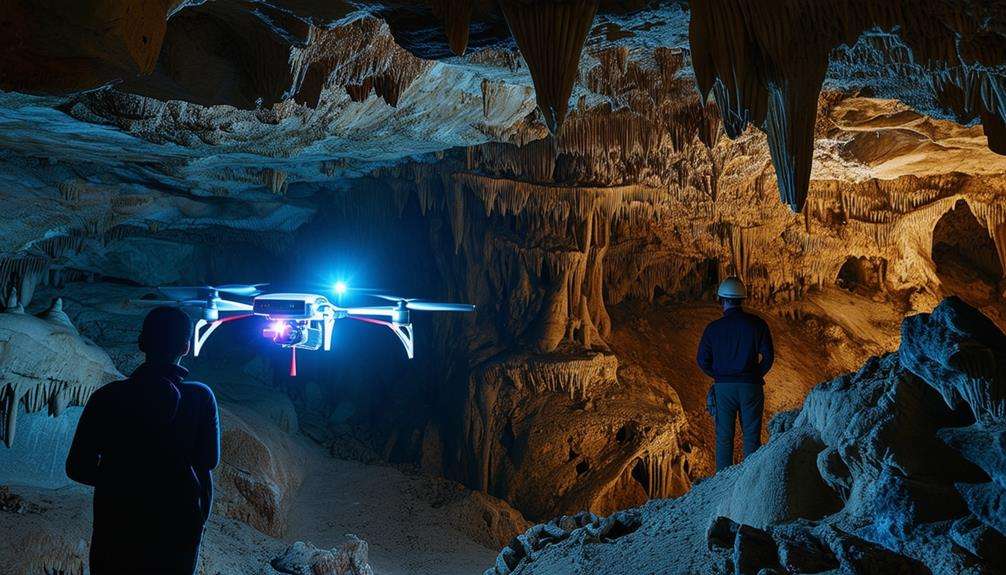Is There an Anti Drone System?

Yes, there are effective anti-drone systems available. These systems can detect and neutralize unexplained drones using radar, RF analyzers, cameras, optical and infrared sensors, and acoustic technology. You can rely on RF jammers, cyber takeover systems, net guns, GPS spoofers, high-power microwave devices, lasers, and even specially trained birds for neutralization. Command and control systems manage these tools to maintain airspace security and address any threats swiftly. Legal regulations must be considered due to privacy and operational challenges. To explore how these technologies keep high-risk areas secure and the latest innovations, there's much more to uncover.
Key Takeaways
- Anti-drone systems detect and neutralize unauthorized drones in sensitive areas like airports and military bases.
- Detection technologies include radar, RF analyzers, cameras, optical sensors, and acoustic sensors for comprehensive monitoring.
- Neutralization methods feature RF jammers, cyber takeover systems, net guns, GPS spoofers, and high-power microwave systems.
- Command and control systems integrate detection and response technologies for real-time airspace security.
- Legal and regulatory considerations are crucial in deploying anti-drone systems to ensure compliance and address privacy concerns.
Understanding Anti-Drone Systems
When it comes to understanding anti-drone systems, you'll find they're a crucial part of modern security frameworks. These systems utilize advanced detection technologies like radar, RF analyzers, and cameras to identify unauthorized drones in real-time. They incorporate optical and infrared sensors to enhance surveillance capabilities, especially in low-light conditions. By picking up on signals and movements, they classify potential threats quickly and efficiently.
Mitigation techniques are just as vital in neutralizing these threats. Anti-drone systems employ methods such as RF jammers, which interfere with the drone's communication, and cyber takeover systems that can hijack control of the drone. Physical options, like net guns, capture drones without causing harm to the environment.
Advanced technologies, including high-energy lasers and microwave systems, are being developed to disable drones from a distance. These innovations aim to reduce collateral damage while enhancing the overall effectiveness of security measures. By integrating multiple detection and mitigation techniques into unified command and control platforms, anti-drone systems offer robust protection across various sectors. This layered defense ensures that any potential risks posed by drone threats are managed swiftly and effectively, safeguarding essential assets and infrastructure.
Detection Technologies Overview
Detection technologies form the backbone of effective anti-drone systems, providing the critical ability to identify and track unauthorized drones. You rely on a variety of these technologies to ensure comprehensive drone detection. Radar technology is a popular choice, capable of detecting small objects like drones over long distances. However, it might struggle to differentiate drones from birds, which can be a significant challenge in certain environments. In emergency response situations, high-resolution cameras are critical for capturing detailed images, and similar technology can be used in anti-drone systems for visual confirmation. In contrast, Radio Frequency (RF) analysers work by passively monitoring the radio spectrum. They detect communications between drones and their controllers, making them a cost-effective option for detection. But remember, they have limited tracking capabilities, which might not always meet your needs. Optical sensors, on the other hand, use AI-enhanced cameras to visually confirm drone activity. They're effective across different lighting conditions, yet you should be cautious of their high false-alarm rates. Similarly, acoustic sensors focus on the sound signatures of drones, an effective method even in noisy settings. Unfortunately, they usually offer a limited range compared to other methods.
Types of Drone Countermeasures

While detection technologies lay the groundwork for identifying unauthorized drones, countermeasures take the next step by neutralizing the threat. These counter-drone systems vary in approach, from disrupting communication to physically capturing drones. Radio Frequency (RF) jammers can effectively disrupt a drone's connection to its operator, though their use is often restricted. Cyber takeover systems offer a more sophisticated method, allowing you to seize control and safely land or redirect the drone.
Physical neutralization methods like net guns and high-energy lasers provide direct action solutions. Net guns capture drones with precision, while lasers can disable them by damaging their structure. GPS spoofers, on the other hand, send false signals to confuse the drone's navigation system, primarily used in military settings.
Here's a quick comparison:
| Method | Description | Application |
|---|---|---|
| RF Jammers | Disrupts drone-controller communication | Limited by regulations |
| Cyber Takeover Systems | Gains control over drone operations | Safe redirection |
| Physical Neutralization | Uses nets or lasers for direct interference | Precision required |
| GPS Spoofers | Alters GPS coordinates to mislead drones | Military use |
| High Power Microwave | Emits pulses to disrupt drone electronics | Risk of communication issues |
Advanced Neutralization Methods
Advanced neutralization methods offer cutting-edge solutions to counter unauthorized drones effectively. These advanced neutralization technologies provide a range of options, each with unique benefits and applications. GPS spoofers, for instance, alter a drone's course by sending false signals, making them ideal in scenarios where stealth is essential, typically within military operations. They manipulate the drone's navigation system, leading it astray without physical engagement.
High Power Microwave (HPM) devices are another powerful tool. They emit electromagnetic pulses that can disrupt a drone's electronics and cause it to shut down. While effective, they require careful deployment to avoid unintended disruptions to nearby communications.
For a more hands-on approach, net guns physically capture drones by ensnaring them in nets. They're highly effective but demand precise targeting and are best suited for close-range engagements.
Laser systems offer a futuristic solution by destroying drones from a distance. These systems, like those tested by the U.S. Navy, are low-cost and efficient, providing a rapid response to aerial threats.
Lastly, trained birds present a unique aspect of counter-drone technology, showcasing nature's role in intercepting and neutralizing drones. These methods collectively enhance your ability to protect sensitive airspace.
Integrating Detection Technologies

In the realm of counter-drone operations, integrating detection technologies is crucial for safeguarding airspace. You need a robust system that combines various methods to ensure comprehensive drone detection. By using radar, RF analysers, optical sensors, and acoustic sensors, you can enhance detection capabilities in diverse environments.
Radar technology offers long-range detection and precise localization of drones, making it an essential component of your counter-drone strategy. Meanwhile, RF analysers play a vital role by passively monitoring communication signals between drones and their controllers, providing a critical layer of insight into drone activity.
On the visual front, optical sensors equipped with AI-powered cameras track drones, offering the advantage of visual evidence, though they might trigger more false alarms. These sensors give you the ability to visually verify drone presence, essential for any subsequent legal action.
Acoustic sensors are another piece of the puzzle, detecting the distinctive sounds drones make. They are particularly useful in noisy environments, helping pinpoint the direction of an incoming drone. By adopting a layered approach that combines these technologies, you ensure comprehensive airspace security and significantly boost the effectiveness of your counter-drone operations.
Command and Control Systems
Some might say that command and control (C2) systems are the backbone of effective counter-drone operations. They integrate and coordinate various detection technologies, providing you with the necessary tools to combat drone threats. By utilizing advanced C2 software like ESG's ELYSION and DedroneTracker.AI, you can process data from multiple sources, ensuring real-time situational awareness and informed decision-making. This integration is crucial for maintaining robust airspace security.
C2 systems boast a modular design, allowing them to support a wide range of detection technologies such as RADAR, cameras, and RF analyzers. This ensures comprehensive coverage and adaptability to diverse security scenarios. The interoperability of data within these systems enhances their effectiveness, enabling seamless communication between different technologies and platforms essential for a cohesive defense strategy.
Moreover, continuous innovation in C2 systems incorporates AI and machine learning, enhancing detection accuracy and reducing response times. These advancements help you stay ahead of evolving drone threats, providing a dynamic and responsive approach to airspace security. By leveraging these cutting-edge technologies, you can ensure that your counter-drone measures remain effective and efficient in the face of emerging challenges.
Protecting Key Assets

Safeguarding crucial assets from drone threats is paramount, especially in high-risk areas like airports, military bases, and public events. Anti-drone systems are essential tools in protecting key assets from potential security risks posed by unauthorized drone activity. By deploying these systems, you can effectively shield critical infrastructure from drone threats that could otherwise compromise safety and operations.
Detection technologies play a pivotal role in identifying and tracking these threats. Solutions such as Dedrone's use advanced AI and machine learning to enhance detection accuracy, significantly reducing false positives. This ensures that the surveillance of sensitive areas remains reliable and efficient. By integrating multiple technologies like radar, optical sensors, and RF analyzers, comprehensive airspace security can be achieved, providing a robust defense against drone incursions.
Once a threat is detected, neutralization technologies come into play. Tools like net guns and high-energy lasers offer effective means to physically capture or disable rogue drones, neutralizing the threat they pose. Additionally, customizable counter-UAS technology solutions, including jammers and radar systems, can be tailored to meet specific security needs. By implementing these advanced measures, you ensure the protection of your key assets against evolving drone threats.
Legal and Regulatory Considerations
Navigating the legal and regulatory landscape of anti-drone systems can be complex, as laws differ widely across regions. You'll find that legal frameworks governing these systems vary significantly, with many countries imposing strict regulations, especially on civilian use. It's crucial to ensure compliance with local laws to avoid legal troubles. For instance, using jamming devices or other countermeasures might interfere with legitimate drone operations, which could lead to severe penalties.
Privacy concerns are another significant issue. Anti-drone technologies can sometimes infringe on individuals' rights, especially in populated areas. Therefore, you must consider these aspects carefully to prevent unintentional privacy violations. Working closely with law enforcement agencies can help enhance compliance and effectiveness in countering unauthorized drone activities. Such collaborations ensure that you're adhering to regulatory standards while addressing potential threats.
Additionally, there are ongoing discussions about the ethical implications of using lethal force against drones. These conversations highlight the need for clear regulations and internationally accepted norms. As you navigate this landscape, remember that understanding and adhering to these legal and ethical standards is essential for responsible and effective deployment of anti-drone systems.
Emerging Trends in C-UAS

The landscape of counter-unmanned aerial systems (C-UAS) is rapidly evolving, driven by technological advancements and the imperative to address growing threats. You'll find that integrating AI and machine learning into these systems is revolutionizing how we detect drones. These technologies enhance accuracy, allowing for quicker responses to emerging threats in airspace security. There's a noticeable shift towards developing compact, non-kinetic C-UAS solutions. These aim to effectively neutralize unauthorized drones while minimizing collateral damage, a crucial balance for maintaining safety.
Multi-layered defense systems are becoming a priority in the defense sector. By combining radar, RF analyzers, and optical sensors, these systems provide comprehensive coverage, ensuring no drone goes undetected. The demand for advanced anti-drone technologies is surging, fueled by evolving threats and significant investments from military and defense sectors. Collaboration between military entities and tech companies is fostering innovation, resulting in sophisticated countermeasures to neutralize drones tailored for specific operational needs.
As these trends continue, staying informed about emerging C-UAS solutions will be essential for safeguarding airspace. With these advanced technologies, you're equipped to tackle the challenges posed by unauthorized drones head-on.
Addressing Operational Challenges
Dealing with operational challenges in counter-drone systems requires a strategic approach to navigate legal landscapes and technological advancements. You face hurdles, especially when legal restrictions limit the use of jamming and interception technologies in civilian areas. This can severely impact how effectively you deploy counter-drone measures. The key is to stay ahead by continuously adapting to the rapid evolution of drone technologies, including homemade and state-developed drones.
Regulatory frameworks differ by region, which means you must ensure that your counter-drone solutions comply with local laws and address privacy concerns. This can be a complex task, as these regulations can significantly impact how you detect and mitigate drones. You also need to be mindful of the risk of collateral damage when using kinetic countermeasures, which highlights the importance of precision in your neutralization methods.
Achieving effective counter-drone operations hinges on the successful integration and interoperability of various detection and mitigation technologies. By enhancing these capabilities, you can better manage the operational challenges posed by drones in complex environments. Staying informed and agile in your approach will help you navigate the intricate landscape of counter-drone systems.




